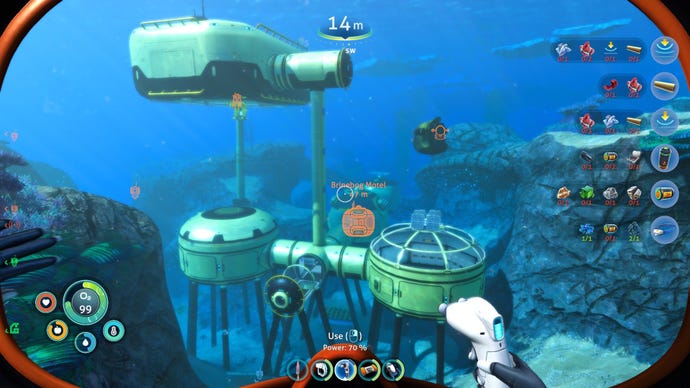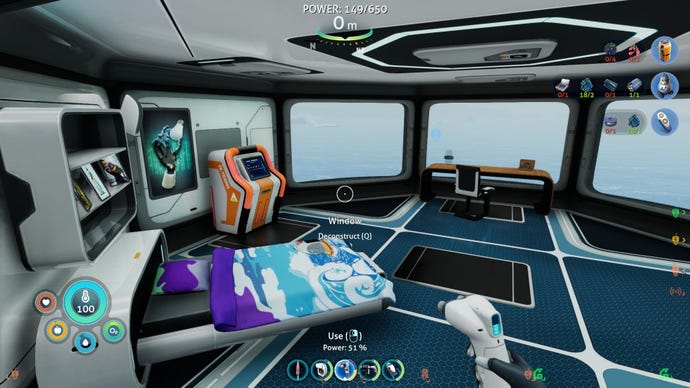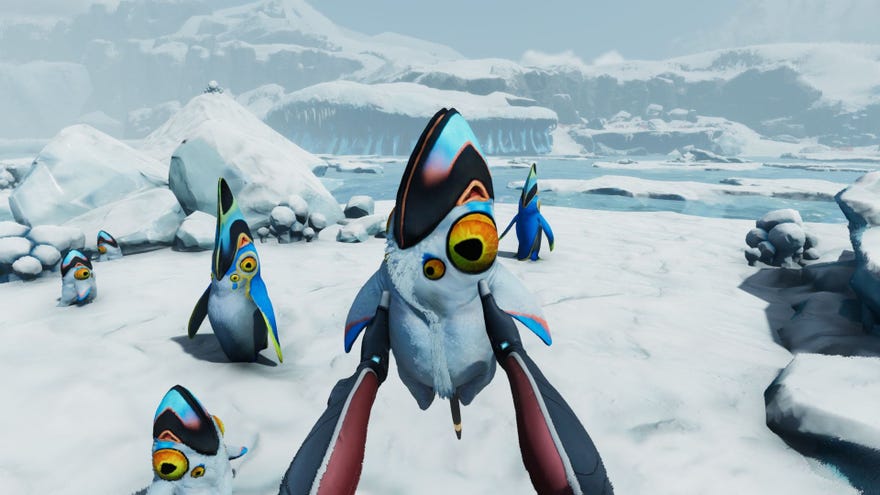Subnautica: Below Zero review
Immersive swim
Well, spit in my goggles and give me the bends, they've done it again. The first Subnautica remains one of the best survival games you can shake a stick at. It stranded you on a planet whose surface was an endless vista of tranquil water and peaceful moons. In Subnautica: Below Zero breaching the surface is more likely to see you taking gulps of air in a hideous blizzard. There are hailstones, sharp winds, thick whiteouts. In the first game you learned to suppress your desire to live close to an inviting surface. In this wintry follow-up, the surface hates you and the water is your refuge right from the start.
You're not a marooned crash-lander this time, but a self-exiled scientist who's trying to find out what happened to her sister on this alien planet. The megacorporation Alterra says she died of "negligence". Naturally, they're covering something up. But they've been careless enough to leave abandoned stations all over the polar region of Planet 4546B, the same waterworld as the last game. Down you go as a rogue researcher to scan fish, craft underwater mechs, drill for copper, and build a subaquatic base of your own while poking your oxygen mask into every coral reef and icy tunnel in search of the truth behind your sister's death.
Already you can see a stronger focus on story than its predecessor. You still get much of it from audio logs found in wreckage. But there is straight dialogue too. As the rebellious Robin, you're a voiced character, and you're not totally alone. I don't think that's something the series needed to do (I'm perfectly happy with silent protagonists) but having more chatter bouncing around doesn't take anything away either. If anything, it adds some personal stakes and focus to a world where goals can and do shift with every little discovery.
The story is thicker this time round, but it can still take a backseat.
It helps that the voice acting is adept and all the characters have strong personalities, especially those in the audio logs. There is Fred, an affable seatruck driver with a Ron Swanson moustache. Or Zeta, a squeezed middle-manager who prevaricates whenever her workers report problems. And then there's Emmanuel, the love-to-hate expedition head who has become the embodiment of corporate doublespeak. "What do you think of reorganising our expectations," he says to his wife, "to facilitate longer-term separation success?" Shut up, Emmanuel. Shut up and drown.
The story is thicker this time round, but it can still take a backseat for as long as you like. Much of your time is spent exploring, harvesting resources, and cautiously approaching creatures that may or may not try to eat you. Again, the animals are the highlight. There are returning staples, like the bladderfish you zap to create drinkable water. But plenty of new threats too, like the ferocious… actually, no, you can find out yourself. It's more fun that way.

What's neat is the animal behaviour. Some fish become docile and sluggish at night, making them easier to catch. The Rock Puncher (a giant mantis shrimp that uses ludicrous club arms to wail on tiny grubs) will unearth rocks and minerals while it hunts. The cheeky Sea Monkeys are human-sized fish pranksters who I avoided for hours, because they have an annoying habit of stealing your gadgets right out of your hands and gliding off with a bubbly chuckle. But they redeem themselves, eventually.
It's more of what Subnautica has always been good at. Presenting you with an alien lifeform of suspicious intent, then pushing you closer and closer with each encounter. In the first game there were animals that seemed terrifying at first glance, but turned out to be gentle, like the massive, groaning Reefbacks. In Below Zero, this trick is repeated, but also flipped, introducing some creatures that look approachable and neat, but turn out to be nasty.
Practically speaking, there are lots of small tweaks and toys to improve the quality of your underwater life. You can pin recipes to your HUD to keep track of what you're looking for. There's a handheld material scanner to hunt down bits of metal on the go. And a "quantum locker" that acts as universal storage (imagine Resident Evil's magic room-spanning storage trunks). For your seabase, there's a control room where you can shut down power in particular rooms, or choose the colour of its exterior, or even give it an illustrious name like, I don't know, The Brinebog Motel.
Making a good base is pleasant, yet the true joy of a Subnautica comes in exploring. There's a lot more land in this one. Or rather, ice. The derelict, frozen research buildings of Alterra are great to stumble across, and traversing the landscape has its own problems. A temperature meter drops rapidly when on the surface, and you have to huddle up to steam vents, drink coffee, or eat alien peppers to fend off hypothermia. Or you can cosy next to a Thermal Lily (big buzzing flowers that emanate warmth like a living space heater). There are, of course, other things to worry about on the surface. Such as the lethal, pitiless, bloodthirsty-- oh right, I forgot, I'm not telling you that stuff.

I'm not telling you because Below Zero, like its older sibling, excels when you're ignorant going in. It encourages cautious but courageous exploration. There is a thing cats do. Every night they rove to ever-increasing distances in a neighbourhood, like spokes on a wheel, always returning to a central point of safety. Subnautica games turn you into a cat. You venture down a 200m ravine to the south, then come back to count your goodies. You get lost in a cave to the west, then scramble frigidly back to reassess your goals. If you could GPS tag sub players (and maybe developers Unknown Worlds have) you'd see the same catlike patterns of exploration and homeseeking.
This loop of danger, safety, and pushing further every time, is key to Subnautica design. I recognise not everyone will play this way. Some will build multiple bases along the way, and these sea nomads risk ruining my nice cat metaphor. But then again, what suburban feline does not have several homes?
Players not versed in the first Subnautica's rhythms might appreciate this guiding HUDhand.
Sometimes the game directs you out to specific waypoints in a blunt manner (a character explicitly tells you to go to such-and-such a place). Players not versed in the first Subnautica's rhythms might appreciate this guiding HUDhand, and the same goes for those who liked the first game but dropped out from a lack of direction. I often ignore these suggestions in favour of investigating random crevices, trenches, wrecks and ice floes at my own leisure. Every so often I remember: "Oh yeah, I should probably go do what the story tells me". Because for my space bucks, it's best enjoyed when you take your time, set your own small goals (build a greenhouse, build a solar farm) between investigating the important sites that pop up on your HUD.
And let me take a moment to nod appreciatively at that HUD. The Legend of Zelda: Breath of the Wild is often praised for making exploration meaningful by putting map-stamping tools into the player's hands. Subnautica games pull a similar trick, except that they remove the abstraction altogether. There's no map to pull up and find an interesting forest to stamp. Instead, there are deployable beacons. If you stumble across a stretch of sea floor with tons of quartz deposits, and want to mark it, you have to take out a floaty flag and plop it in place, naming it "QUARTZLAND" or "GLASSBOTTOM" or "DRILL HERE". Now it'll appear on your HUD, along with a distance readout. It's the magic cartography of Zelda via holographic bookmarks you can turn on and off at will, so as not to clutter the screen.

There is some light bugginess. Fish clipping briefly through walls. A few bubbles appearing in plain air inside your HQ. I saw one cute metal spider trapped in level geometry and that was very sad. The base building can also sometimes feel temperamental, letting you build a corridor or room one moment, disallowing it the next. There are usually reasons a once-green structure turns a rejecty red (other items blocking the way for instance), the real problem is it's sometimes hard to tell exactly what the problem is. These are infrequent problems though, quirks that never took me out of the survivalist fantasy for long.
There is a more important question: if you have not played Subnautica, should you play this? Well, you could. I'd rather you play this than play neither of them. But for me, Below Zero is the perfect continuation of a series, rather than the perfect starting point. The previous game works as a better introduction to the corporatised universe and alien discoveries, whereas this is very much a fan's sequel. Its incremental improvements make it a better game, technically speaking (and they don't change how you play, which is good - Subnautica weren't broke, so deren't fix it). But this one has such an expanded focus on characters, lore, background and environmental storytelling, that fans of the first are getting the best deal. The catastrophic hijinks of those rascals at Alterra are best appreciated when you've lived through one marooning by corporate malfeasance already.
Either way, it's another superb explorer's game. If you like looking behind waterfalls, try these frozen cascades. As an insufferable manager of a futuristic corporation might say: Come on, are you a subnautican or a subnautican't?
(Get bent, Emmanuel)










